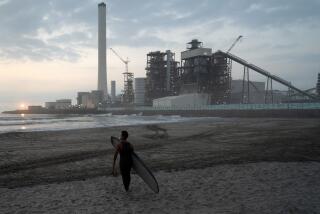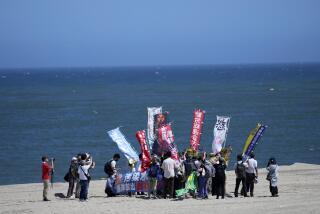Japan crisis probably won’t end China’s commitment to nuclear power
Reporting from Beijing — China has joined Germany, France, Russia and other nations now pledging to review their atomic energy programs in the aftermath of the nuclear crisis sparked by Japan’s devastating earthquake and tsunami.
FOR THE RECORD:
Energy in China: A March 19 Business article about China’s nuclear power industry misspelled the name of Yang Fuqiang, senior advisor on climate and energy at the Natural Resources Defense Council, as Yan Fuqiang. —
Premier Wen Jiabao announced this week that China would put a moratorium on construction of new nuclear power plants while it updates safety standards. But China’s insatiable thirst for energy will probably ensure that its long-term commitment to nuclear power continues.
China last year overtook the U.S. to become the world’s largest consumer of energy. It depends on fossil fuels for 91% of its needs, much of that from high-polluting coal. Chinese President Hu Jintao has said he wants renewable sources to produce 15% of China’s energy by 2020.
To meet that goal, China is developing wind, solar and hydroelectric power. But it’s also building nuclear reactors faster than any other country in the world. China currently operates 13 nuclear reactors, with 27 under construction and more than 150 planned.
“The Chinese have been building nuclear reactors like hot cakes for five to 10 years, and they’re going to continue to do this,” said Mark Hibbs, an expert on nuclear policy at the Carnegie Endowment for International Peace.
Projects in China currently represent 60% of all new nuclear power plant construction worldwide. In the wake of the Japanese disaster, the Chinese market is likely to become even more important for companies such as Westinghouse, which is designing many of China’s new reactors.
“Most of the developed world is going to put a freeze, temporarily, on new nuclear projects at least until they can learn whatever lessons seem appropriate from Japan,” said Donald Straszheim, a senior China analyst at ISI Group. “But in China, new demand needs to be satisfied. Vendors worldwide, watching the stutter-step in growth elsewhere, will be increasingly amenable to dealing with China because they know that is where the long-term growth will be.”
But entry into the Chinese market comes at a cost. The government typically requires foreign companies to partner with domestic firms and transfer technology.
Despite foreign assistance, China’s nuclear industry is still playing catch-up, with most reactors being built with designs based on 30-year-old technology. Most of China’s new reactors are being constructed along the nation’s eastern coast, making them vulnerable to tsunamis, experts said. Questions also remain whether China will have enough qualified workers and safety regulators.
“China has made a big push to train engineers, but I don’t think that’s enough,” said Yan Fuqiang, senior advisor on climate and energy at the Natural Resources Defense Council. “China needs to do more; otherwise, if a nuclear disaster happens, we won’t have anyone to deal with it.”
The World Nuclear Assn. noted in a review of China’s nuclear industry that “while staff can be technically trained in four to eight years, safety culture takes longer at the operational level. This issue is magnified in the regulatory regime, where salaries are lower than in industry, and workforce numbers remain relatively low.”
Corruption has also plagued the Chinese industry. The head of China National Nuclear Corp., Kang Rixin, was fired in 2009 for “a serious disciplinary violation,” a frequently used euphemism for corruption, and eventually sentenced to life imprisonment.
One of China’s oldest nuclear power plants, Daya Bay, in Guangdong province not far from Hong Kong, experienced several minor accidents last year. But the company’s opaque reporting system gave little clues as to what the problems were. The most serious occurred in November and was rated Level 1 out of seven on the International Atomic Energy Agency’s incident scale. By comparison, the current crisis at the Fukushima Daiichi plant in Japan has been deemed a Level 5.
Although there were no health risks associated with the Chinese incidents, many in Hong Kong were concerned when it was revealed that the most serious accident went unreported by the Chinese plant owners for three weeks.
Critics of atomic energy welcomed China’s plans to halt construction and approval for new plants — if only temporarily.
“It is high time for the Chinese government to take a look at its nuclear ambitions, especially because of the high cost and long build times,” said Li Yan, a climate and energy specialist at Greenpeace. “With the Japan nuclear crisis, it provides the Chinese public a chance to understand they are also very close to nuclear power plants.”
More to Read
Inside the business of entertainment
The Wide Shot brings you news, analysis and insights on everything from streaming wars to production — and what it all means for the future.
You may occasionally receive promotional content from the Los Angeles Times.










